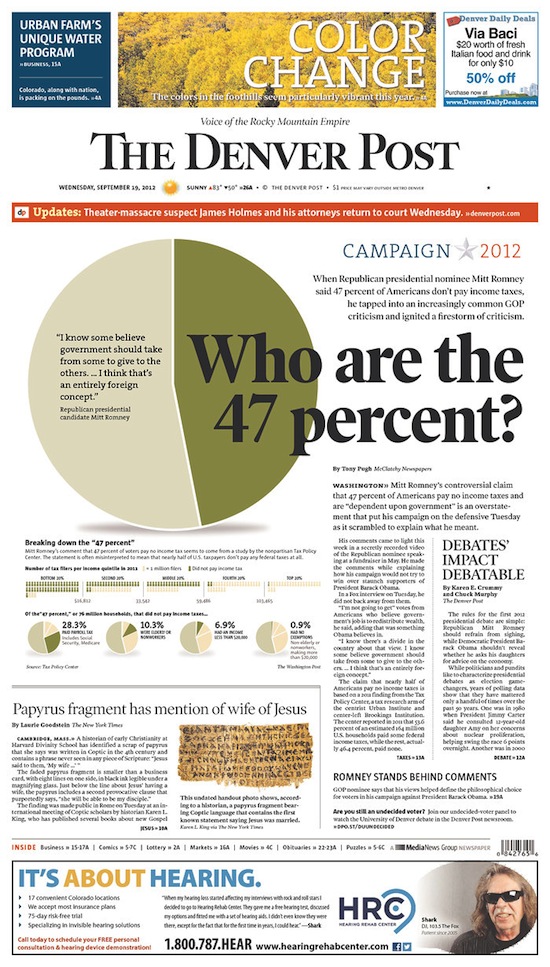
The secret video recording of Mitt Romney’s now-infamous “47 percent” comment went live on the Mother Jones website at 4 p.m. Eastern Time on Monday. Within a few hours—if that—the political Twittersphere could speak of nothing else. The recording dominated political media like no other story to date in the presidential campaign, garnering nearly two million pageviews for Mother Jones in just 12 hours and spurring scores of commentary and follow-up reported posts across the Internet.
Away from the realm of wired political obsessives and back in the land of print media, of course, something like the traditional news cycle still operates. So it wasn’t until Wednesday morning that the controversy over Romney’s comments made the front page of many metro regional newspapers. But when it got there, it landed in a big way: BuzzFeed’s Andrew Kaczynski found coverage of “47 percent” on the front page of 41 separate swing-state dailies.
Editors of those papers knew, of course, that by that time the existence of the video wouldn’t be news to even most casual readers—so the dailies would have to do something to advance the story. But many regional papers don’t have the in-house resources to advance a national political story, especially if there’s no compelling local angle. Scan through the front pages compiled by Kaczynski, and you’ll see a smattering of local bylines, like this striking piece by the Detroit Free Press’s Todd Spangler, but many more wire takes on Romney’s comments: various AP accounts; a McClatchy article; write-ups borrowed from the NYT, LAT, and WaPo.
Even so, there were important editorial choices to be made at local papers—in particular, which elements of the story to emphasize in Wednesday’s editions. Brendan Nyhan noted for CJR the other day that much of the early coverage failed to clearly explain who the 47 percent who don’t pay federal income taxes are, and whether they can plausibly be considered, as Romney claimed, “dependent upon government.” Since that early point, much of the coverage has been better on this score. Local editors picking copy off the wire had access to a McClatchy story by Tony Pugh that delved into those issues, and a similar AP piece by Alan Fram. On the other hand, they could also choose familiar material like a second AP article that tracked the political sparring over the video, reciting what various political leaders said and situating the controversy in a broader “Romney in trouble” narrative.
There’s nothing wrong with featuring that horse race frame somewhere in your report. But the right move here was to foreground explanatory coverage that scrutinized Romney’s rhetoric. The Denver Post earns a laurel for doing just that, and in a big way. Here’s the Post’s front page on Wednesday, courtesy of the Newseum’s website:

Pugh’s explanatory story is given pride of place, splashed across A1 above-the-fold. The giant pie chart illustration is basically just a signal that the story is important, but the graphic below it, borrowed from The Washington Post, carries a lot of information, including a correction of a common misinterpretation of the 47 percent figure in the accompanying text. This is strong editorial judgment—emphasizing the most important part of a story, telling it in multiple ways, and presenting the package in a big, bold way. (Interestingly, the front page teased to inside coverage of the political fallout and Romney’s semi-embrace of his remarks—presumably this New York Times account, which was picked up on the Post’s website. That ran on A19.)
It’s worth acknowledging that Pugh’s story, while a solid effort, has its limitations. It’s basically a write-up of an interview with Roberton Williams of the Tax Policy Center, source of the “47 percent” figure; it read to me like a less-webby, less-policy-fluent version of a post from Ezra Klein’s “Wonkblog” crew. (The equivalent Wonkblog post, which was punchier, clearer, and featured many more charts, was of course up before noon on Tuesday.) But nonetheless it’s a notable—and welcome—development to see a policy explainer dominate the front page of a metro newspaper.
Laments over the plight of those newspapers are a dime-a-dozen; The Denver Post, like many others, has shifted its resources away from national politics. But even in a straitened era, these publications are important news sources, and there are opportunities for them to deliver creative, valuable coverage to their readers. In this case, the Post made the most of such of an opportunity.
Related posts:
“Jumping the gun on the Romney ‘47%’ video”
“It’s Caucus Day in Colorado: Where’s the Content?”
Greg Marx is an associate editor at CJR. Follow him on Twitter @gregamarx.
